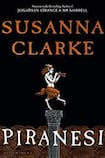
Fifteen years have passed since Susanna Clarke captivated the imaginations of four million readers worldwide with her bestselling debut, Jonathan Strange & Mr Norrell. Her epic tale of 19th-century England, in which two magicians emerge to change history, was unlike anything published before – the 782-page fusion of magic, mythology and the fantastic with Austen-esque Regency manners proved irresistible.
In the ensuing silence, Clarke’s legion of newly devoted fans had reason to believe it was a feat so extraordinary that the novelist could not, or would not, dare to repeat it. With the exception of an anthology of short stories, The Ladies of Grace Adieu, that was set in the world of Jonathan Strange and published soon afterwards in 2005, there has been no white smoke rising from the chimney of Clarke’s home in Derbyshire. Until now.
The long-awaited second novel, Piranesi, has arrived, albeit at a third of the size of its predecessor. And yet, as if it has been infused with the otherworldly spirit of its contents, the novel’s scope and literary extravagance extends far beyond what its physical matter suggests could be possible. Once again we enter a realm of fantasy but this time we have magical realism in a postmodern world.
Piranesi is our protagonist and unreliable narrator who guides us through the House he inhabits (his use of capitalisation is particular and deliberate). Through his meticulous notetaking, we are offered an introduction to the World that begins in “the year the albatross came to the southwestern halls”.
Piranesi is on a quest to explore and document as much of the World as is within his power – as such, the reader learns that he “has climbed up to the Upper Halls where Clouds move in slow procession and Statues appear suddenly out of the Mists” and that he has “explored the Drowned Halls where the Dark Waters are carpeted with white water lilies”.
The records of tides thundering up staircases, the thousands of statues and the ephemera Piranesi discovers are strangely compelling. In the absence, to begin with, of any particular narrative, the prose casts a spell of its own – there is something chilling and unnerving about the intoxication of the language luring us further into the House.
Slowly we learn that Piranesi is not alone. The Other is introduced to us as a colleague – a man on whom Piranesi depends upon for companionship but also occasional creature comforts – and the person who named him Piranesi.
The original Piranesi, whom we assume inspired The Other’s choice of name, was an 18th-century Italian printmaker and artist who was renowned for his etchings of Rome and, in particular, his elaborate, fictitious, atmospheric depictions of prisons. He was an architectural fantasist whose association with our protagonist offers us an early glimmer of suspicion that Piranesi’s understanding of the World may be inconclusive at best.
The Other is obsessed with uncovering the Great and Secret Knowledge that he believes is hidden within the House – forgotten knowledge that will grant him “strange new powers” – and Piranesi is his accomplice. It becomes clear that all is not quite as our narrator believes it to be and a mystery borne of a very real England unravels in the midst of this otherworld – the only home he thinks he has known.
The novel begins with an epitaph from Laurence Arne-Sayles, whom we learn more about later, in which he suggests that he is an “anamnesiologist”: “I study what has been forgotten. I divine what has disappeared utterly.” This very particular form of magic is the connective tissue that supports Clarke’s fantastical odyssey – the power of what is remembered, the shadow of what has been lost. Piranesi cannot remember his past and so we travel with him on his journey towards self-discovery and understanding.
The association with memory loss and trauma is poignant – has Piranesi wilfully forgotten as a coping mechanism? Can he only escape his plight by wilfully forgetting it? When he reads old journal entries he worries that in the past he lost his mind for his own records are mysterious to him. His “outlandish words” are unrecognisable and make him anxious: “A crowd of images stirs in my mind – strange, nightmarish but at the same time oddly familiar.”
Piranesi, the novel and man both, are luxuriously enigmatic and the labyrinthine House they inhabit is intoxicating. This novel is an enchanting, dark, multilayered offering that more than lives up to the power of its predecessor. However, the less you know in advance of reading it the better. As Piranesi writes, “The Beauty of the House is immeasurable; its Kindness infinite.”











